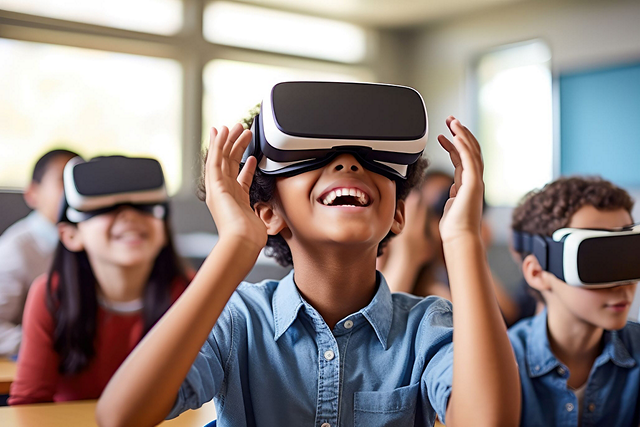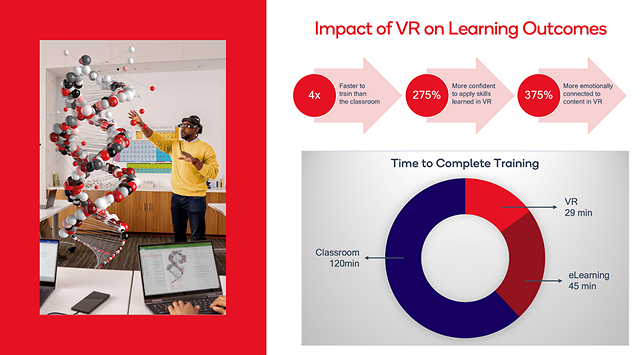How To Unlock Student Potential With Today’s Technology
Virtual reality solutions could produce improved learning outcomes compared to traditional teaching methods
As we now possess pre- and post-COVID academic data, we can see the magnitude of learning loss that has occurred across the globe. Test scores in math and literacy confirm that far fewer children are achieving proficiency levels in core curricula. A recent study states it will take five or more years for many older children to recover from pandemic learning loss.1
Despite introducing technology to more classrooms around the globe, too often we find that educators embrace analog thinking when applying digital solutions.
If all we do is substitute textbooks and worksheets for digital texts and portable document files (aka PDFs), we haven’t changed learning — we’ve merely figured out how to spend more money to do the same old thing.
Over the last decade, I have visited hundreds of kindergarten through grade 12 classrooms and university lecture halls across several countries. Even among the technology-rich institutions and countries, many remained caught in a time capsule. I typically see students:
- Typing in a word processing application (keyboarding is still in most curriculum);
- Typing text and pasting images they found online into presentation slides; or
- Reading, watching and possibly responding to multiple choice questions in some web-based content created by a publisher.
Our responsibility is to rethink the concepts of teaching and learning, employing the best practices to deliver meaningful academic outcomes.
The history of passive versus active learning
In the 1960s, educational researcher Edgar Dale released his now-famous Cone of Experience.2 What he was trying to convey was those passive methods of learning — such as learning by listening, reading or watching — delivered poor results. However, he stated that when the learner is more actively involved in the process — such as through discussion, simulation or teaching others — that learner is likely to master the concepts faster and retain the information longer.
What learning method is more effective for students?
I reflect back to when I was a fourth-grade student at Rushmore Elementary School on Long Island, New York. I think my classroom experience mirrored that of many who are reading this article. What did a typical day in school comprise?
- The teacher lectured us on a given topic in front of a chalkboard.
- We read from textbooks.
- And if it was a good day, we would get to see a filmstrip or movie.
Now let’s jump ahead to a technology-rich classroom pre-, during and post-COVID. How did technology change this learning?
- Teachers continue to lecture to students in front of an interactive flat panel, or the students watch previously recorded lectures created by educators.
- Students read from digital textbooks.
- And if it’s a good day, they get to watch YouTube videos.
Now, if we were to compare these teaching and learning strategies from the 1970s to today, we can observe that many of the techniques define learning as a passive experience for the student. We continue to listen, read and watch, which are the very strategies that Dale defined at least 50 years ago as delivering the worst results. Meanwhile, we’ve invested in expensive technology to support these strategies with digital tools, but we continue to rely on analog learning. And when schools invest significantly in technology and fail to see any improvement in academic outcomes, this remains the root of the problem.
Bringing active learning methods into the classroom
If we re-examine the teachings of Dale, we see that more active methods of teaching and learning — Learning by Doing — empowers students to understand the relevance, while processing the knowledge in a very different and more effective way. Fortunately, there’s a technological solution that embraces digital pedagogy at its roots, setting the stage for accelerated learning and greater results.
Virtual Reality (VR) remains an outlier in schools and countries, but it shows the greatest potential for students to gain mastery in complex concepts faster and with greater retention.
Recent studies involving major corporations have shown that students can be trained four times faster than traditional methods.3 Further, learners are significantly more confident in applying the skills learned because of hands-on simulations. Why does VR deliver far more effective learning experiences versus traditional analog teaching methods?
- Rather than trying to process abstract concepts, students complete purposeful experiences that help them understand in more tangible ways.
- VR allows students to see the cause and effect of right and wrong answers, bringing greater levels of understanding to the topic. Even when they make a mistake, they learn from it.
- VR makes learning more emotionally relevant by witnessing lessons firsthand.
How VR can improve learning outcomes
If we can apply VR to skills such as those across science, technology, engineering, arts and mathematics — aka STEAM learning — imagine the possibilities for the next generation of students. VR cannot remain solely used among early adopters for an occasional game or class activity. If integrated into the core curriculum, we can help more students gain mastery in areas such as literacy and math, areas that continue to remain a challenge for many nations.
A recent study by WestEd, conducted during the 2022–2023 school year, helped demonstrate the impact of VR use in math instruction.4 Students who supplemented their instruction with VR content from publisher Prisms of Reality witnessed an 11% improvement in test scores when compared to the control group of students.
But as we stretch the definition of the learning space and what can and should occur in classrooms, we open the door to limitless possibilities. Technologies that can reshape teaching and learning include many new innovations that Qualcomm Technologies is helping shape for future generations, including immersive VR simulations, drone and robotic technologies, machine learning and artificial intelligence.
Our mantra “Engineering Human Progress” showcases our desire to help transform learning in classrooms across the globe. With more than 1.6 billion students in the world today, their learning is the greatest natural resource to benefit our world in the years to come.
1: Elementary students are recovering faster from Covid learning loss, research shows. EdSource. Retrieved on May 18, 2023 from: https://edsource.org/2022/elementary-students-are-recovering-faster-from-covid-learning-loss-research-shows/675811
2: Edgar Dale’s Cone of Experience: A Comprehensive Guide. Growth Engineering. Retrieved on May 22, 2023 from: https://www.growthengineering.co.uk/what-is-edgar-dales-cone-of-experience/
3: What does virtual reality and the metaverse mean for training? PwC. Retrieved on May 18. 2023 from: https://www.pwc.com/us/en/tech-effect/emerging-tech/virtual-reality-study.html
4: WestEd Study: Virtual Reality as a Catalyst for Mathematics Learning. Prisms of Reality. Retrieved on July 24, 2023 from: https://www.prismsvr.com/blog/virtual-reality-as-a-catalyst-for-mathematics-learning




